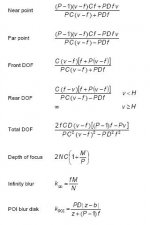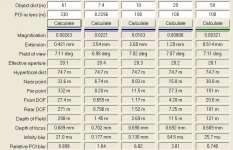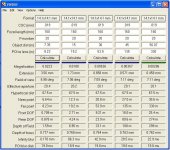henry link
Well-known member
Ok, I've simmered down a bit now. I think it's best to take on only one Dunnism at a time, so I'll confine my comments to the claim that "stands to reason" from the quote below.
..."If you are a photographer, you know that when your aperture is wide open your photo has a shallow depth of field (so only the subject, or part of the subject, is in focus). When the aperture is narrow, you increase depth of field (so more of the world remains in focus).
It stands to reason that a binocular that is very bright will result in the user’s pupil constricting, thus increasing depth of field."...
Notice that this claim is for a real increase in optical DOF (not a subjective impression of DOF), caused by a change in the aperture and focal ratio of the eye from a rather small increase in light transmission.
Does this really make sense? If an increase in light transmission simply stimulates the eye's pupil to compensate by constricting then virtually all binoculars would appear equally bright. There wouldn't be any "very bright" ones. To use a Dunnish phrase, Pupil Constriction Peter would rob Higher Light Transmission Paul. Anyone who has compared an old single layer coated bin to a fully multi-coated one knows this doesn't happen, but never mind, let's assume it does. The supposed increase in optical DOF from a brighter image can be put to the test using the defocused star method I described earlier.
I picked two 7x50 binoculars with very different light transmission, a Nikon 7x50 Prostar with state of the art transmission in the 90-95% range and an old Leitz 7x50 with transmission around 75%. The difference in brightness between the two is quite obvious, but when I tested them for DOF using the defocused artificial star method I could see no difference at all. I should mention that I even increased the sensitivity of the test by using two closely spaced star points at a distance that caused the edges of the defocused discs to barely touch in both binoculars. Even a very slight difference in the size of the discs would have been visible.
Alas, this isn't the first time I've found myself dismayed by Pete Dunne breezily disseminating an optical myth of his own invention, without testing it or bothering to think it through.
..."If you are a photographer, you know that when your aperture is wide open your photo has a shallow depth of field (so only the subject, or part of the subject, is in focus). When the aperture is narrow, you increase depth of field (so more of the world remains in focus).
It stands to reason that a binocular that is very bright will result in the user’s pupil constricting, thus increasing depth of field."...
Notice that this claim is for a real increase in optical DOF (not a subjective impression of DOF), caused by a change in the aperture and focal ratio of the eye from a rather small increase in light transmission.
Does this really make sense? If an increase in light transmission simply stimulates the eye's pupil to compensate by constricting then virtually all binoculars would appear equally bright. There wouldn't be any "very bright" ones. To use a Dunnish phrase, Pupil Constriction Peter would rob Higher Light Transmission Paul. Anyone who has compared an old single layer coated bin to a fully multi-coated one knows this doesn't happen, but never mind, let's assume it does. The supposed increase in optical DOF from a brighter image can be put to the test using the defocused star method I described earlier.
I picked two 7x50 binoculars with very different light transmission, a Nikon 7x50 Prostar with state of the art transmission in the 90-95% range and an old Leitz 7x50 with transmission around 75%. The difference in brightness between the two is quite obvious, but when I tested them for DOF using the defocused artificial star method I could see no difference at all. I should mention that I even increased the sensitivity of the test by using two closely spaced star points at a distance that caused the edges of the defocused discs to barely touch in both binoculars. Even a very slight difference in the size of the discs would have been visible.
Alas, this isn't the first time I've found myself dismayed by Pete Dunne breezily disseminating an optical myth of his own invention, without testing it or bothering to think it through.
Last edited:







